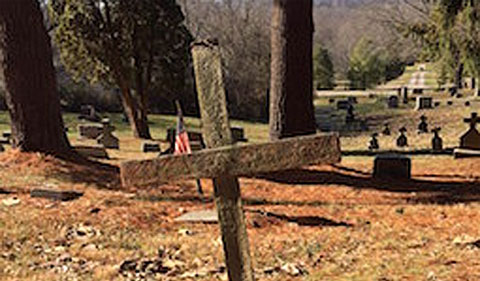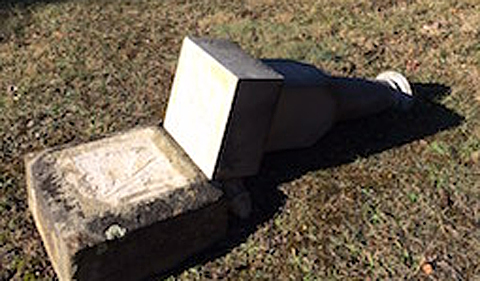
OHIO sophomore Alison Harper studied three cemeteries, including St. Patrick’s (pictured here), to find demographic and mortality information about a rural Appalachia population. Her work is supported by the Provost’s Undergraduate Research Fund. Photographer: Kelee Riesbeck
By Zulfa Rizqiya
Anthropology major Alison Harper is looking below Appalachia’s surface to better understand its history. In her research paper “Mortality Analysis from Cemeteries,” Harper sheds light on demographic and mortality rates and causes in a rural area of Appalachia between 1880 and 2014.
Harper’s research is supported by Ohio University’s Provost’s Undergraduate Research Fund (PURF), a program that provides funding for costs incurred by undergraduate students who engage in research and creative activity. Students can use their award—up to $1,500 is awarded—to defray costs associated with conference travel, exhibit building and with producing performances.
Harper and her research team collected data from three cemeteries in Buchtel, a village in southeast Ohio: Saint Patrick’s Cemetery, Old Miners Cemetery (also called “Buchtel Cemetery”) and Dew Cemetery to understand trends in the population’s mortality rates and causes through time. “The cemeteries were selected to provide a better representation of the population,” Harper said. “Saint Patrick’s is Catholic, as are many of the people in the area; Old Miners is a pauper’s cemetery; and Dew is a local cemetery, so anyone could be buried there.”
After surveying the cemeteries, Harper and her research partners, Abby Guerra, a junior studying Anthropology and Sociology-Criminology, and Dr. Nancy Tatarek, Associate Professor of Anthropology, were able to match all of the grave sites with a corresponding death certificate. From there, they analyzed the most common causes of death with respect to age and gender. Their research revealed a trend: Mortality was related to the rich coal mining history and health problems associated with the profession. Harper and her team used the data to compare it with census records from the surrounding township to shed light on how representative the cemetery samples are of mortality rates and causes in rural Appalachia as a whole.

Buchtel Cemetery, or Old Miners Cemetery, is where paupers were buried. OHIO sophomore Alison Harper studied three cemeteries to find the mortality causes in an area of Appalachia. The project was supported by the Provost’s Undergraduate Research Fund.
Photographer: Kelee Riesbeck
Presenting at Social Science History Association Conference in Chicago
Harper presented her research at the November Social Science History Association Conference in Chicago. The opportunity allowed her to develop her presentation skills and network with people in her field from all over the world.
“As my first academic conference, I was given a lot of great, constructive criticism and advice on how to improve,” she said. “It was also nice to network internationally, talking and comparing my project with other students.”
Harper’s research is part of the Appalachia Population History Project (APHP), a dynamic regional study that engages students and faculty in scholarly, educational, and collaborative opportunities. She attended the conference with fellow researcher Guerra and Tatarek, who also is the director of APHP.
“Alison is a hardworking, thoughtful and enthusiastic student who is developing into a good, young anthropologist,” Tatarek said. “She’s only in her second year, and I expect that she will continue to develop as a scientist.”
With an academic conference under her belt, Harper plans to eventually earn a doctoral degree in anthropology. Harper seeks a future career in criminal or human justice.
“I’ve already done a lot of work on human trafficking,” Harper said. “I would love a job in either law enforcement or human trafficking in an anthropology standpoint. If within anthropology, I’d like to work on criminal-related research.”


















Comments